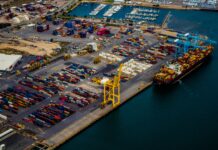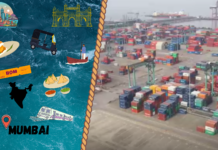
Adani Group is moving closer to commanding 50% of the Indian containerised trade, powered by its aggressive terminal network expansion and strategic partnerships with major container lines.
Exclusive port data collected by Container News shows Adani’s countrywide port network is now handling about 43% of container volumes shipped in and out of India, with its flagship Mundra Port leading that play. Adani has ongoing terminal joint ventures with leading box lines MSC and CMA CGM.
The group, out of its five container-handling port locations, racked up some 723,000 TEU in May and about 714,000 TEU in June, while total Indian volumes hit 1.66 million TEU and 1.7 million TEU, respectively.
Of that, Mundra contributed some 550,000 TEU in May and 558,000 TEU in June (including volumes handled by DP World Mundra, or MICT), according to the latest data.
That market share is poised to expand further with Adani targeting to open a dedicated container-handling facility in Gangavaram Port next year. This is an east coast gateway it acquired a year ago.
As a result, the growth gap between Mundra and Nhava Sheva/JNPT is widening, after the former became the country’s largest container handler in fiscal 2020-21.
“FY22 has been a stellar year for APSEZ [Adani Ports & Special Economic Zone], with the achievement of various milestones for itself and new benchmarks for India’s maritime industry,” said Karan Adani, CEO of APSEZ. “The company marked a record cargo volume of 312 MMT with Mundra Port alone handling 150 MMT, a feat never achieved by any other commercial port in the country.”
He added, “We are confident of APSEZ’s growth prospects in FY23, given India’s expected GDP growth and boost to India’s Iron and Steel industry from China’s decision to cap its steel production and absence of exports from Russia. APSEZ is fully geared to ride this wave.”
With Gangavaram Port added, APSEZ has operations out of 12 port locations in India. Gangavaram, a deep-water, multi-purpose minor complex located close to Visakhapatnam, currently features nine cargo berths with an annual capacity of 64 MMT.
APSEZ is looking to become a 400-MMT cargo handler by 2025, compared with 312 MMT moved during fiscal 2021-22, up 26% year-over-year.
“The acceleration of our cargo volumes is a manifestation of our ability to continue to execute on our strategy,” pointed out Adani, who went on to explain, “Our network of ports across the Indian coastline coupled with our integrated logistics capabilities, focus on technology enabled digitised operations and, most importantly, the deep relations that we have built with our customers and partners (that include the global shipping lines), are all coming together to make APSEZ full-fledged integrated ports & logistics platform that augments each other.”
Adani noted, “We anticipate our growth to continue to accelerate given our capabilities that are now best-in-class and the tailwind of a growing Indian economy.”
Jenny Daniel
India correspondent
Contact email: j.daniel@container-news.com





